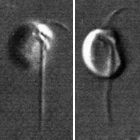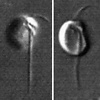Ancyromonas melba
David J. PattersonIntroduction
Cells are 5-7 µm long, oval shaped and dorso-ventrally flattened with the ventral side hollowed. The anterior end of the cell is set off by a ventral groove running from the left lateral margin to the right ventral part of the cell. The resulting 'snout' has a few indistinct granules running along it. The vental groove continues longitudinally as a slight ventral crease. The cell usually glides on a posterior flagellum which emerges near the anterior-most termination of the ventral groove. This flagellum is usually held under the cell during gliding. The posterior flagellum is 1-2 times cell length and tapers gradually along its length. The anterior flagellum emerges from a slight depression at the right anterior end of the cell and sweeps in front of the cell as it glides. This flagellum is about the length of the cell and is of similar thickness as the posterior flagellum.
This species has been reported from hypersaline habitats in Western Australia and from Antarctica (Patterson and Simpson, 1996).
Characteristics
This species is strongly reminiscent of the widespread and common Ancyromonas sigmoides in size, dorso-ventral flattening, gliding, presence of a groove from left margin to right ventral side of cell, refractile granules along the snout, posterior flagellum arising from ventral depression, and anterior flagellum if present arising from small depression near the base of the snout. It can be distinguished from A. sigmoides because, in A. sigmoides, the anterior flagellum is short or non-existent. Also, the groove in A. melba is located exclusively on the ventral surface, while the posterior part of the groove of A. sigmoides runs along the margin of the cell. In A. melba cells the recurrent flagellum lies closer to the mid-line of the body, whereas in A. sigmoides it is located marginally or projects from the side of the cell, and A. melba is usually larger and appears more ventrally hollowed.
The prominent anterior flagellum of A. melba makes it easy to distinguish this species from Metopion fluens. Caecitellus parvulus has a prominent anterior flagellum like A. melba but differs because the two flagella appear to emerge from the anterio-posterior axis of the cell. Caecitellus has an ingestion apparatus supported by a hoop of cytoskeletal material and no rostrum.
References
Patterson D. J. and Simpson, A. G. B. 1996. Heterotrophic flagellates from coastal marine and hypersaline sediments in Western Australia. European Journal of Protistology 32:423-448.
Title Illustrations

| Scientific Name | Ancyromonas melba |
|---|---|
| Image Use |
 This media file is licensed under the Creative Commons Attribution License - Version 3.0. This media file is licensed under the Creative Commons Attribution License - Version 3.0.
|
| Copyright |
© 2000 David J. Patterson

|
About This Page
David J. Patterson

Marine Biological Laboratory, Woods Hole, Massachusetts, USA
Page copyright © 2000 David J. Patterson
 Page: Tree of Life
Ancyromonas melba .
Authored by
David J. Patterson.
The TEXT of this page is licensed under the
Creative Commons Attribution License - Version 3.0. Note that images and other media
featured on this page are each governed by their own license, and they may or may not be available
for reuse. Click on an image or a media link to access the media data window, which provides the
relevant licensing information. For the general terms and conditions of ToL material reuse and
redistribution, please see the Tree of Life Copyright
Policies.
Page: Tree of Life
Ancyromonas melba .
Authored by
David J. Patterson.
The TEXT of this page is licensed under the
Creative Commons Attribution License - Version 3.0. Note that images and other media
featured on this page are each governed by their own license, and they may or may not be available
for reuse. Click on an image or a media link to access the media data window, which provides the
relevant licensing information. For the general terms and conditions of ToL material reuse and
redistribution, please see the Tree of Life Copyright
Policies.
- First online 04 October 2000
Citing this page:
Patterson, David J. 2000. Ancyromonas melba . Version 04 October 2000. http://tolweb.org/Ancyromonas_melba/2454/2000.10.04 in The Tree of Life Web Project, http://tolweb.org/











 Go to quick links
Go to quick search
Go to navigation for this section of the ToL site
Go to detailed links for the ToL site
Go to quick links
Go to quick search
Go to navigation for this section of the ToL site
Go to detailed links for the ToL site